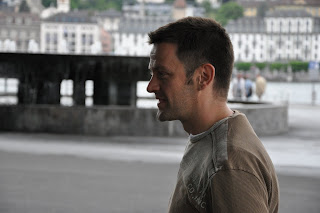Today a friend and I took a free 2 hour photo course in Luzern! We were taught how to use the basics of our cameras - how to set the ISO, speed and aperture. I had have unknowingly/knowingly played around with these things with our old digital camera but never really paused to fully understand them - so it was nice to be taught on my Nikon.
I'll break up the 2 main things that he taught in separate posts (with examples) so as not to overwhelm. But first, as a foundation, he explained the significance of the ISO number. The brighter your setting, the smaller the ISO number. We set our ISO's ahead of time. It was a cloudy day and he recommended 1600.
*My friend stresses that whenever you turn your camera on and you're working in any of the M,A,S or P settings that you automatically think ISO and set it accordingly.
(My camera goes anywhere from 200-3200 plus some additional ones whose meanings I am not sure of)
I'll break up the 2 main things that he taught in separate posts (with examples) so as not to overwhelm. But first, as a foundation, he explained the significance of the ISO number. The brighter your setting, the smaller the ISO number. We set our ISO's ahead of time. It was a cloudy day and he recommended 1600.
*My friend stresses that whenever you turn your camera on and you're working in any of the M,A,S or P settings that you automatically think ISO and set it accordingly.
(My camera goes anywhere from 200-3200 plus some additional ones whose meanings I am not sure of)
Depth of Field/Aperture
~The Depth of Field refers to how much of your picture is in focus~
~Aperture refers to the amount of light that the camera is letting in~
1. Greater Depth of Field = All of your picture is in focus which is perfect for landscapes
2. Shallow Depth of Field = Your subject is in focus but the background is blurred
The part that is hard to keep straight is what aperture number leads to what depth of field.
Greater Depth of Field needs a smaller opening (less light) which means a large aperture number (f25)
Shallow depth of field needs a larger opening (more light) which means a smaller aperture number (f3.8)
So basically...landscapes = a high f number
Portraits = small f number
- When learning to use the camera in Aperture mode we made sure the dial on the left was set to A. We then changed the aperture by spinning the main dial on the front right side of the camera.<--I've used the auto portrait setting so I know what look I want to be achieving but the manual is what I've needed to learn!
Here are the pictures that I took when learning about Aperture/Depth of Field. I'm really picky about my pictures so I'm sending out a HUGE disclaimer that these are not great - as in we were all just randomly shooting eachother and the model, talking and goofing around =)
:: Greater Depth of Field ::
:: Greater Depth of Field ::
{f16}
:: Shallow Depth of Field ::
:: Shallow Depth of Field ::
{f5.3}
Notice the difference in backgrounds?
Notice the difference in backgrounds?
Tomorrow I'll post what he taught/pictures regarding the Shutter Speed =)



4 comments:
that is so useful tip!
thanks for the tips! I'm currently saving for a camera so classes like these will be useful! :)
www.romance-is-boring.blogspot.com
xx
thanks! sorry if it was long winded :)
I love your photography tips! I've always wanted to take a class. Maybe after this I won't need to. ;)
xo
Valerie
Post a Comment